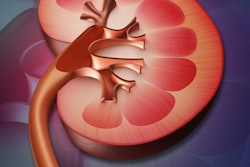Using CT with a reduced tube-current protocol to image patients with suspected renal stones is as sensitive as full-dose studies, according to a research presented at this month's RSNA meeting by researchers from New York University Langone Medical Center in New York City.
Renal stones are common in younger patients, with a reported prevalence of 2% to 3% of the population and a peak incidence at 20-40 years of age, said Shaun Patel, MD, who presented the study in Chicago. With reported sensitivities of 95% and higher, noncontrast CT is considered the gold standard for imaging, having all but replaced abdominal radiography, ultrasound, and intravenous pyelography (IVP).
"However, patients tend to be younger and undergo multiple CT scans over the course of a lifetime," Patel said, referencing a 2006 study by Katz et al that found that among 4,500 patients with a history of renal colic, 19% underwent six or more CT scans over a six-year period, and 4% had three or more scans. "Therefore, ionizing radiation is an important consideration."
As for cutting dose, previous studies have focused on reducing mAs but not kVp, he said. "There is a complex nonlinear relationship between radiation dose and kVp that has not been well studied," he said.
In their retrospective study, Patel and colleagues Nicole Hindman, MD; Ojas Shah, MD; Aron Bruhn, MD; Christianne Leidecker, PhD; Michael Macari, MD; and Hersh Chandarana, MD, examined 25 patients (23 men, two women; mean age 57 years) who underwent noncontrast dual-energy CT (DECT) (Somatom Definition, Siemens Healthcare, Malvern, PA) in 2007 and 2009 at the center.
The scanner has two x-ray tubes operating at right angles, and DECT data were acquired with the first tube operating at 140 kVp and 56-80 mAs, and the second tube at 80 kVp and 370-480 mAs. Other scanner settings included 1.2-mm collimation, gantry rotation time of 0.33-0.5 seconds, and pitch of 0.5-0.7, Patel said.
The comparison data were synthesized from the original DECT data by reconstructing it to generate a weighted-average (WA) dataset, with equivalent image quality to a standard 120 kVp acquisition.
"This is a merged average of 80 and 140 kVp, and multiple prior studies have shown that this simulates the image quality of standard 120-kVp acquisition," Patel said.
Data were sent to PACS as 4-mm axial sections. In addition, a "pure" 80-kVp dataset was sent to a standalone workstation as 4-mm axial sections.
A single radiologist with more than four years of experience analyzed the images for presence, size, and attenuation of kidney stones, and the results served as the reference standard for the study, Patel said. Next, images from the 80-kVp acquisition were reviewed independently by two readers who were blinded to the weighted-average images, and interpretation of the 80-kVp dataset was compared to the reference standard. Finally, effective radiation doses were estimated and compared to the 120-kVp images in 15 consecutive patients.
The reference standard showed 84 stones in 17 patients, and no stones in eight patients, with a mean size of identified stones of 3.5 mm (1.0 mm to 3.7 mm). The mean attenuation was 289 HU (range, 57-1,079).
"In the 80-kVp acquisition, we demonstrated excellent correlation in size and attenuation compared to the reference standard, with no significant differences in size or attenuation," Patel said. "On the 80-kVp images, both readers identified all 17 patients with renal stones, and all eight patients without stones, resulting in 100% per-patient accuracy."
Seventy-nine stones (94% sensitivity) were detected by one reader and 80 (95% sensitivity) by the second reader -- and the same three stones (all ≤ 2 mm) were missed by both readers, he said. The average attenuation of the missed stones was 81 HU (range, 57-112 HU). The estimated 80-kVp radiation dose as measure by CT dose index (volume) (CTDIvol) was significantly lower than the standard 120-kVp acquisition (7.5 versus 12.7 mGy; p < 0.0001), he said.
Study limitations include its small cohort and retrospective design, Patel said. No patient weighed more than 198.4 lb (90 kg). In addition, only renal stones were evaluated. "We didn't have enough ureteral and bladder stones in our patient cohort," he said.
"80-kVP acquisition can potentially detect renal stones with high accuracy and significantly lower radiation doses" compared with 120 kVp, he said. "In the future, we plan to test the accuracy of low-mAs 80-kVp acquisition using denoising algorithms. This has the potential to further reduce the radiation dose."
Asked by the session moderator if he had an explanation for the three missed stones at low kVp, Patel said the low HU values (57-112) are in the range of uric acid stones. Two were 2 mm or smaller and a third was a low-attenuating 3-mm stone. "I don't really think they would have changed the clinical management of the patients ... they were really low-attenuation stones and small stones," he said.
By Eric Barnes
AuntMinnie.com staff writer
December 23, 2010
Related Reading
Use of CT grows in children with urolithiasis, September 15, 2010
DECT permits more detailed urinary stone analysis, December 4, 2008
Low-dose CT offers first-line exam for suspected urolithiasis, September 15, 2008
Low-dose multidetector CT accurately evaluates urinary stone disease, March 30, 2007
Copyright © 2010 AuntMinnie.com




















